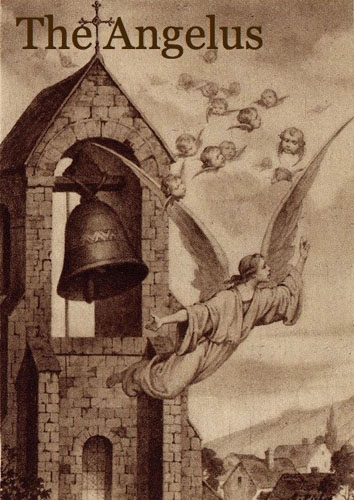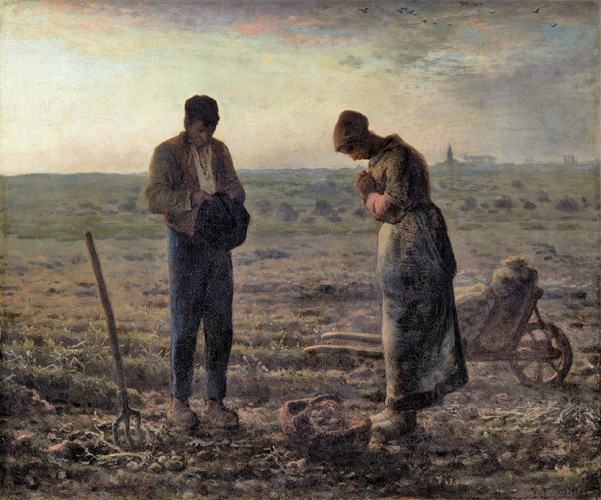
The Angelus Bell from the Christian Family, 1906 Day by day, every morning, noon and evening, the bell of every Catholic Church sends forth, in slow succession, three times three strokes and then a longer peal. To a Catholic the meaning of this is very plain. It is the Angelus bell inviting him to praise God in the great mystery of the Incarnation: and to ask, through the intercession of our heavenly mother, the blessing of Him, who ripens the fruits and gives flowers to the fields. The Angelus Prayer is beautifully composed of various scriptural passages relating to the Incarnation of the Son of God (Luke 1, 26 - 39. John I, 14.) Three times the angelical salutation is repeated: "Hail, full of grace, the Lord is with thee: blessed art thou among women." (Luke 1, 28.) Everyone has heard of Millet's celebrated painting called, "The Angelus" and most of you have seen copies of the picture. Two venerable peasants are standing in the foreground, with hands folded and heads bowed in reverence: and in the distance the spire of the village church peers out of the dark-green foliage. The shades of twilight are falling. The pious Catholic people are listening to the far off peal of the Angelus bell. And as they listen their memories are carried back through the centuries to that beautiful evening of Nazareth; where the Virgin Mary kneels in silent prayer, and, on a sudden, sees before her the resplendent figure of the Angel Gabriel, who greets her: "Hail, full of grace, the Lord is with thee, blessed art thou among women." And seeing this in spirit, the pious souls repeat, according to the ancient Catholic practice: "The angel of the Lord announced unto Mary, and she conceived of the Holy ghost." Again, the bell's soft melody comes floating through the evening air; and they repeat the words of the Virgin: "Behold the handmaid of the Lord; be it done to me according to thy word." (Luke 1, 38.) At the last three strokes, they say: "And the Word was made flesh and swelt among us." (John 1, 14.) Now the bell sends forth a long joyous peal; and they conclude: "Pray for us, O holy Mother of God: That we may be made worthy of the promises of Christ." This is the ancient Catholic practice of the Angelus, which seems to have been foreshadowed by the words of the Psalmist: "Evening and morning and at noon I will speak and declare, and the Lord shall hear my voice." (Ps. 54, 18.). 
The Angelus: V. The Angel of the Lord declared unto Mary. R. And she conceived of the Holy Ghost.
Hail Mary, full of grace, the Lord is with thee; Blessed art thou amongst women, and
blessed is the fruit of thy womb, Jesus. Holy Mary, Mother of God, pray for us sinners, now and at the hour of our death. Amen.
V. Behold the handmaid of the Lord.R. Be it done unto me according to thy word. Hail, Mary etc. V. And the Word was made Flesh. R. And dwelt among us. Hail, Mary etc. V. Pray for us, O Holy Mother of God. R. That we may be made worthy of the promises of Christ. Let us pray:
Pour forth, we beseech Thee, O Lord, Thy grace into our hearts, that we to whom the Incarnation of Christ, Thy Son, was made known by the message of an angel, may by His Passion and Cross be brought to the glory of His Resurrection, through the same Christ our Lord. Amen
(The Faithful who at dawn, at noon and in the evening, or as soon
thereafter as possible, devoutly recite the Angelus, with the appropriate versicles,
and prayer, may gain an indulgence of 10 years each time for themselves or the Holy Souls in Purgatory.)
(Music: The Angelus in Latin) http://catholicharboroffaithandmorals.com/ |